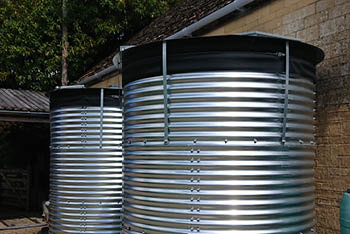Rainwater harvesting
Water is a limited and valuable resource but is also essential for plant growth. Water resources in the UK are under pressure from climate change and population growth.
As part of Forestry England’s aim to be net carbon zero by 2030, a new rainwater harvesting and filtering system has been installed at Westonbirt Arboretum. This new rainwater filter system is a first for Forestry England and will reduce the amount of water being used; completing the facilities that support the recently funded Quarantine House in the arboretum’s Propagation Unit.
Based on an average year’s rainfall, the system has the capacity to collect a massive 90,000 litres of rainwater per year and its collection tanks can store 26,000 litres. That’s equivalent to 132 bathtubs of water!
Under the existing glasshouses, an old underground rainwater collection tank was discovered in the propagation area. Helped by CMW Horticulture, specialists who design and build large greenhouses throughout Europe, an innovative slow sand filter system has been installed to pump, clean and use the rainwater collected in the underground tank.
The system works by collecting rainwater from the Quarantine House and two large glasshouse rooves via downpipes, pumping the rainwater from the underground collection tank into a large tank above ground filled with layers of pebbles and sand to biologically remove organic matter and pathogens from the water as it percolates through; avoiding the use of chemical additives to remove plant pathogens. A second tank stores the filtered water, then a further treatment by UV light takes place before being used for irrigation in the Propagation Unit.
Despite the drought conditions experienced this July and August, with more daily irrigation required to keep the plants hydrated, there was still plenty of water left in the system which proves its ability to provide sufficient water.
“I am really proud to be part of a team that is taking extra measures to protect our valuable historic landscape.”
Penny Jones, Propagator at Westonbirt Arboretum
We want to encourage everyone to consider water conservation and to use resources in a more sustainable way, whilst at the same time reducing carbon emissions and saving money.
So, how can you do something similar in your own garden?
To make the most of water, collect what you can rather than use mains (tap) water. Gardeners should use mains water as sparingly as they can.
Traditionally, this involves harvesting the rain from a roof. The rain will collect in gutters that channel the water into downspouts and then into some sort of storage vessel. Rainwater can be collected from the roofs of homes, garages, greenhouses and other garden structures if they have gutters and a downpipe that enters the drain at ground level. Water butts with rainwater diverters are designed to collect water from the downpipe and still let the overflow enter the drain or soak away.
Encouraged by most water companies, especially in the drier south-eastern counties where rainfall is significantly less than along the west coast
Local councils and DIY stores are good places to purchase basic plastic water butts.
Store and use collected rainwater safely.
